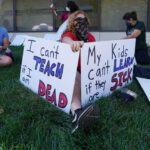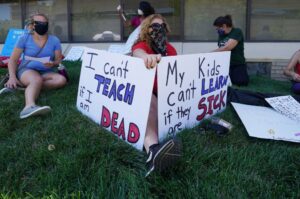Pandemic as Portal? The Fight Around School Reopening


As teachers across the country prepare to return to school, the familiar apprehension that comes with starting a school new year feels drowned out by the uncertainty created by state and district leaders due to the Covid-19 pandemic crisis. The drive to reopen schools has left school districts and state governments scrambling to find ways to push teachers and students into as much in-person schooling as possible, despite the danger of spreading the virus throughout school buildings, putting vulnerable individuals and communities at risk.
This is a situation with no easy solutions. We are told that we must choose between an ever-deepening economic crisis, on the one hand, or the uncontrolled spread of a deadly pandemic, on the other. However, we need to recognize that basis of the choices we’ve been presented with are rooted in the system that created the aspects of this crisis that it hasn’t simply made worse.
We need to reject this Sophie’s Choice, and demand that students and teachers not be sent into conditions that we know will cost some of them their lives. As we have seen in recent weeks, options that blend online and in-person learning to ensure social distancing, do not effectively control the spread, nor can they actually meet the needs of students. Fully online learning is the only way to ensure that we are not putting students and staff at risk. That means we need to demand funding to guarantee that all students have the support they need, including access to high speed internet. It also means that we need to fight to shut down the economy to control the spread of the virus, while doing what needs to be done to ensure that the human needs of families are met.
The Trump administration, as well as state and local leaders, frequently attempt to frame their insistence on getting students and teachers into some form of in-person schooling in terms of supporting students’ academic and emotional needs. Some even rightly point out that the move to online learning has a disproportionate negative impact on students of color and students from low-income households. However, while it is undeniable that our education system is fraught with unacceptable disparities based on race and class, we need to question the motives of those who champion these concerns, while at the same time slashing education budgets and gutting social programs and services that support our most vulnerable communities.
They may pay lip service to the needs of students, but government leaders’ push to get students back into some form of in-person schooling is really about economics. The pandemic has sent the US economy hurtling into a crisis on par with the stock market crash of 1929 and the financial crisis in 2008. In the second quarter of 2020, the United States’ GDP fell 9.5%, and unemployment in July was just over 10%. This crisis is set to deepen, with Congress having failed to extend the stimulus payments keeping many families afloat.
Reopening schools in an online learning setting creates an impediment to the speedy recovery, albeit unlikely, that government leaders hope for. If students are learning from home, then parents will also need to stay home to look after them, thereby forcing families into a position where they must choose to care for their children at home, or go to work to ensure that they have food on the table. On the other hand, forcing schools to reopen in person guarantees that students will bring home the virus, in many cases, though disproportionately in families of color, to multigenerational homes, where they live with older relatives who are more vulnerable to the virus. This is not to mention the risks posed to school staff, many of whom are at high-risk, themselves.
In addition to the obvious health risks associated with any form of in-person schooling, there are several other factors that make returning to school buildings infeasible. To begin with, while we can imagine a socially-distanced classroom with desks spaced six feet apart, anyone who has spent five minutes working in education knows that social distance and kids just don’t mix. Physical proximity is central to how children connect with each other, whether they are playing a game, working together, or just talking. Expecting them to stay six feet apart is simply unrealistic, and is honestly kind of cruel.
Proximity is also essential to caring for children. How do you comfort a crying child from six feet away? How do you distantly help with someone’s shoe laces, or a stuck zipper on a jacket? How do you have a private conversation about missing homework or a rough test score? Invariably these situations will come up, and just as invariably, educators will jump in to help the student, regardless of the risks to their own health.
In addition to social distancing, ensuring that students wear masks while at school has been suggested to help mitigate the risk of spreading the virus. It is absolutely true that consistent mask wearing is effective at preventing viral transmission, and that people should be wearing masks when out in public. However, we have to consider how this will actually play out in schools. Masks are, undeniably, a little uncomfortable, especially when you have to keep one on for long periods of time, like an entire school day. When a student refuses to put their mask back on, in many cases that will become a disciplinary issue, which will disproportionately harm students of color.
However, even if we were able to ensure proper social distancing and mask wearing in schools, there are other factors that make any form of in-person learning unsafe in the context of a pandemic. Due to the chronic underfunding of public education at the hands of both Democratic and Republican governments, school districts around the country are deeply under-resourced and many school buildings are shamefully out of date. In some districts, there are no school buildings that have air management systems that can accommodate the filtration needed to prevent the virus from spreading from classroom to classroom.
Furthermore, schools do not have adequate staffing to split classes into small enough groups for adequate social distancing. As a result, it is likely that we will see Education Service Professionals (ESPs) being asked to take on roles that go far beyond their job description. ESPs are more likely to be people of color, and typically work for low wages. They will be told that they can either take on the extra duties, or lose their job. It is essential that, as teachers fight for a safe and equitable reopening, they take into account ESPs concerns and fight alongside them to ensure that they are taken care of, should online learning interrupt their employment.
The only way to ensure that students and school staff are safe this year is to move to fully online instruction, while protecting school staff and families that won’t be able to work as a result. However, doing so creates other challenges for students, particularly those that require specialized services or English language support, as well as families who rely on school for food support or who lack adequate access to reliable high-speed internet. Government leaders have tried to use these issues to drive a wedge between teachers fighting for a safe reopening, and families that need the services that schools provide.
Rather than implying that self-interested teachers don’t care about the needs of families, these problems actually expose the inadequacy of capitalism to meet human need, and the reality that the fight for a safe reopening necessitates a broader fight for a fundamental reversal of the priorities at the core of the system.
Rather than wasting time trying to make some form of in-person learning work, when we know it won’t, we should be focusing on how to best meet the needs of students and families during a year of online learning. This means a massive influx of funding, firstly, to provide incomes to parents that cannot work, because they need to be home with their students, and also to provide schools with the resources to meet the needs of their community, including meal delivery, access to school health professionals and social workers, and safely providing support to students with disabilities.
This funding should not be seen as an emergency measure. The current crisis has been made far worse due to districts being required to run on a shoestring for decades. The pandemic has made clear the central role that schools play in the lives of families, from providing childcare and education, to meals and mental healthcare. We have a huge opening right now to shift the priorities around education in this country, and fight for better conditions for our students and ourselves.
Now is the time to fight for the schools our students deserve. However, the key to winning that fight is solidarity. In many states, governors have chosen to leave the decision around how schools will open to districts to decide, likewise individual private schools and charters. We need to build fight backs in every state that bring in non-unionized teachers at private schools and charters, transcend district boundaries, and bring separate educators’ unions together in struggle. We also need to build partnerships with families and community members, to ensure that their needs are at the center of what we’re fighting for.
We are going into a very uncertain year, and educators are anxiously looking at a list of bad options, with some even considering leaving the profession, in order to keep themselves and their families safe. However, during this time it is essential that we stick together to fight for a safe return to school, that meets the needs of our students and their families. At the beginning of the pandemic, the author Arundhati Roy said that the “pandemic is a portal,” that we will step through it either carrying with us the baggage of the past, or entering into a new world, with a new set of priorities. What public education looks like when all this is over is dependent on what we, as educators, fight for now, and how we fight for it.